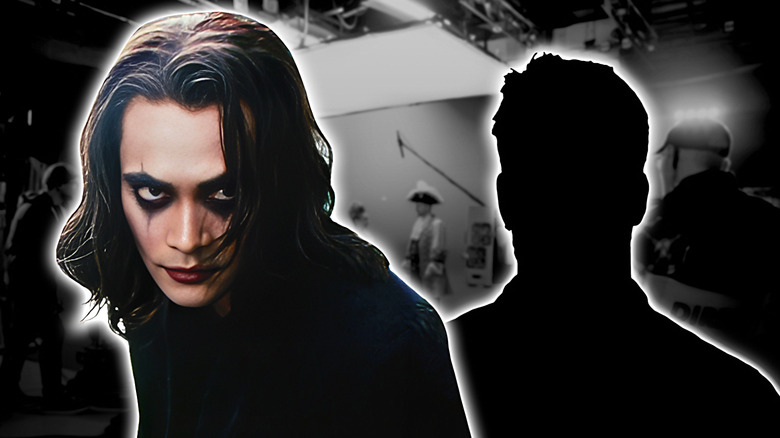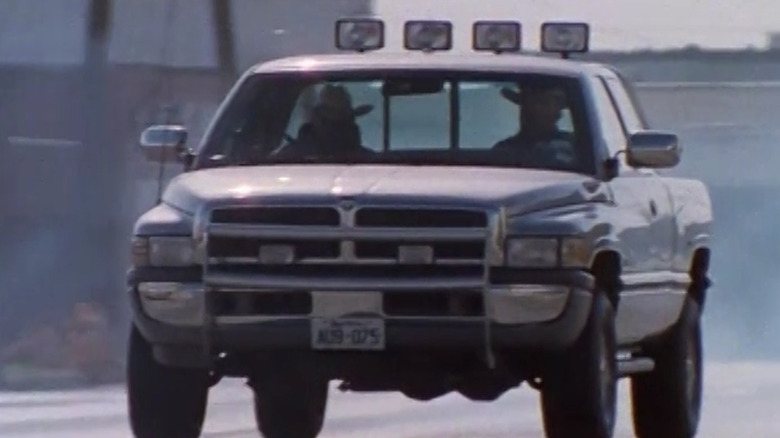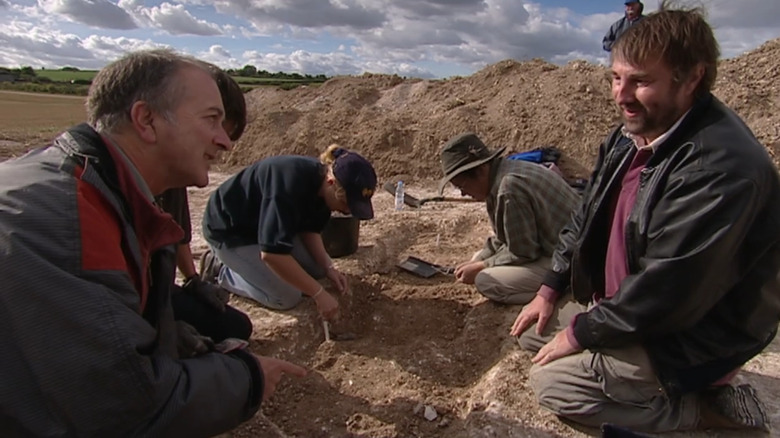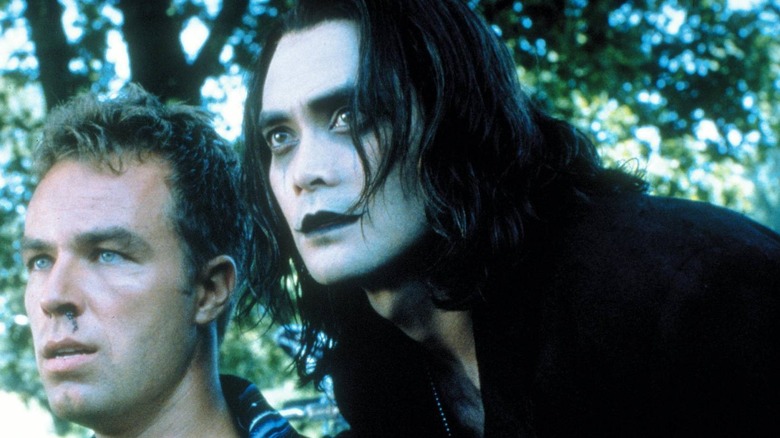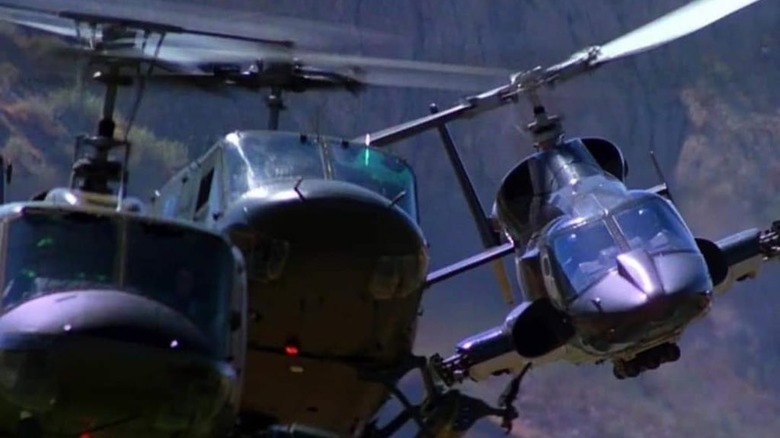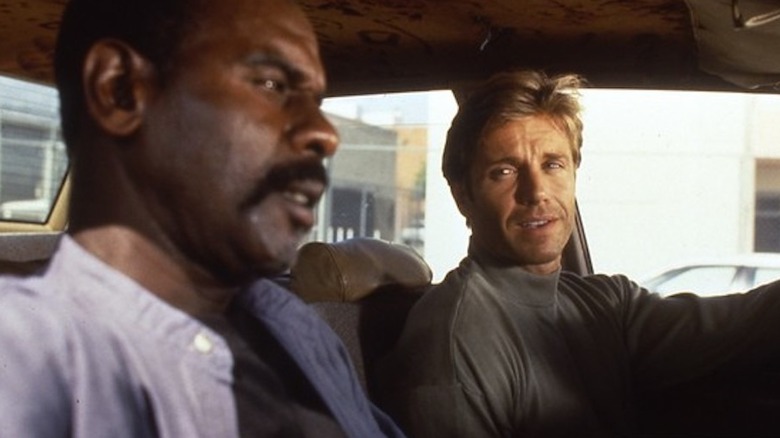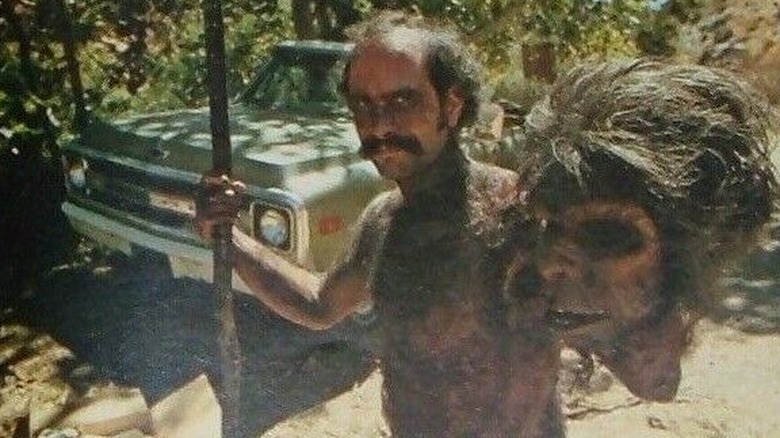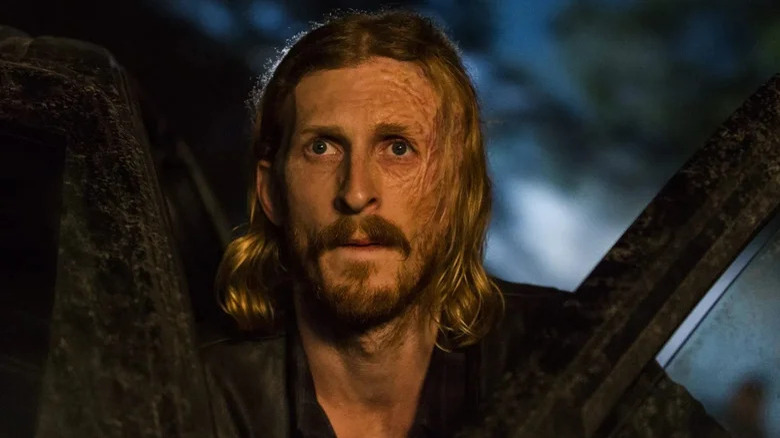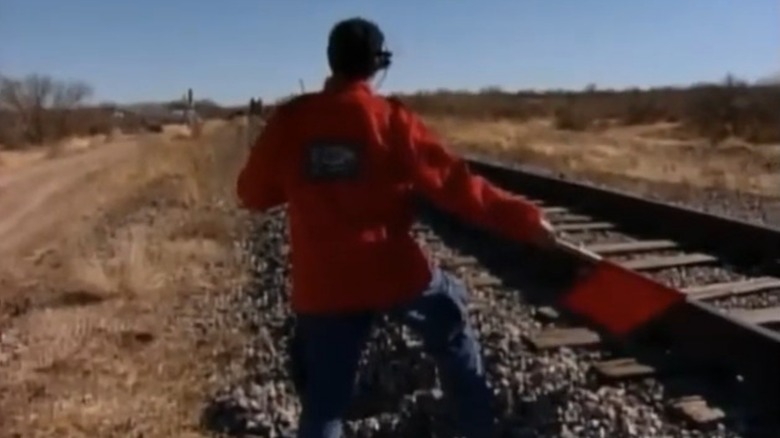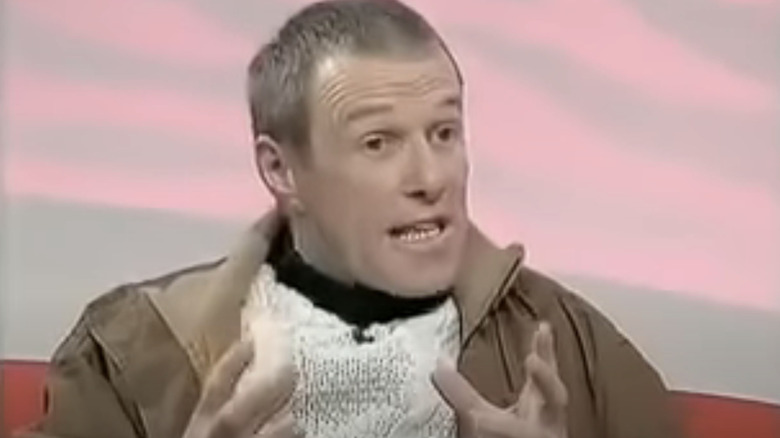TV Scenes That Actually Killed Stunt Actors
Since the earliest days of Hollywood, filmmakers, actors, and studios have continually tried to top each other with bigger and bolder productions. Often, that means more and more daring stunts for action movies, dramas, and even documentaries. On some occasions, though, these risky productions and daring stunts have led to stuntmen suffering from serious injuries, and in rare cases, even death. But movies weren't the only place where stunt actors have lost their lives in tragic accidents.
The ever-escalating audaciousness of TV productions has led to more dangerous stunts, including serious injuries and deaths. Stunt performer deaths aren't as highly publicized as the deaths of big stars, so you might have never even heard of some of these actors. Nevertheless, we'll never forget the stunt actors who've lost their lives to bring audiences the most spectacular stunts. From top TV hits to little-known reality shows, here are some TV shows that stunt actors lost their lives filming.
William Charles Skeen in Walker: Texas Ranger
While audiences haven't seen Chuck Norris headlining a movie in a long time, he was a huge star back in the 1980s, leading classics like "Delta Force," "Missing in Action," and their sequels. In the 1990s he moved to television in "Walker: Texas Ranger," which told the story of Sgt. Cordell Walker, a Texas Ranger, Vietnam veteran, and expert in just about everything, because it's Chuck Norris. In the show, he acts as a one-man fighting force against all manner of bad guys, leading to action-packed installments brimming with bare-knuckled brawls, exciting shootouts, and hard-hitting car chases. And one of those scenes led to the death of stuntman and driver William Charles Skeen.
It happened in 1999 while cameras were rolling on a car chase in Cedar Hill State Park. Skeen was driving a GMC Suburban while making a 140-foot leap through the air and crashing down with a devastating impact. But it wasn't the stunt itself that killed him. Skeen suffered a fatal heart attack during the shooting of the scene, which otherwise went off without a hitch. "It flew through the air like an eagle and didn't do anything weird," police told the Washington Post, acknowledging that the stuntman's safety gear was all in good order.
When the truck landed, though, Skeen was rushed to a nearby hospital, where he died of cardiac arrest. "We are grief-stricken over our friend's sudden and tragic death," star Chuck Norris, who also served as the show's executive producer, said in an official statement.
Paul Allen in Time Team
The British series "Time Team" isn't the sci-fi romp you might expect from its title. In reality, it's a docuseries of sorts that has a team of expert archeologists exploring dig sites around their native UK. The series, which ran for two decades, didn't just do a little subterranean excavation and simple scientific studying, though. On top of all that, the show also recreated historical scenes, and in a 2008 special, "The Real Knights of the Round Table," two participants were brought in to demonstrate a medieval jousting competition that led to the death of stuntman Paul Allen.
For the scene, Allen was fitted with era-specific armor and protective gear, including a helmet that proved to have a fatal flaw. According to an inquest conducted by the Kettering Magistrates' Court, the helmet's eye holes were too large, allowing broken pieces of wood created by a breakaway stunt lance to pass through. In the horrific incident, a large balsa wood splinter lodged itself in Allen's eye, and though he was airlifted to a hospital to have life-saving measures performed, he died from cardio-respiratory failure and a penetrating brain injury, as reported by BBC.
Following his death it was also reported that Allen had no experience jousting, and the helmet he'd been wearing wasn't rated for receiving real offensive strikes, only for less intense stunt fights at carnivals. Ultimately the inquest determined that his death was due to the production hiring an inexperienced rider and the use of the wrong protective gear.
Marc Akerstream in The Crow: Stairway to Heaven
In 1993, martial arts star Brandon Lee famously lost his life while performing a stunt on "The Crow" when a mishap involving prop guns led to him being shot by dummy rounds that acted like real bullets. It was one of Hollywood's greatest movie stunt tragedies, and it cast a pall over the franchise for years, as clever tricks were used to finish the film and preserve Lee's performance. Well, a few years later the studio pressed their luck again with a live-action TV series spin-off, "The Crow: Stairway to Heaven."
The series launched in 1998, starring Mark Dacascos as the violent, vengeance-seeking immortal Eric Draven, resurrected from the dead to seek justice among the living. In a mind-boggling repeat of fate, however, a stunt during the production of the series led to the death of another actor: stuntman Marc Akerstream. The series was filmed in British Columbia, and the incident occurred while filming an action sequence designed to send debris soaring through the sky after a massive explosion. "The piece of debris was sent up in the air, cleared a large tree, and came down to strike the victim on the head," Royal Canadian Mounted Police Cpl. Gary Brine told Variety following the tragedy.
What made Akerstream's death all the more sad was that he wasn't even an active participant in the stunt in question. According to another stunt actor on the series, Akerstream was merely a bystander while filming the scene when the flying debris struck and killed him.
Reid Rondell in Airwolf
One of the most industry-shaking on-set deaths transpired during a television production. While filming a scene for the popular action show "Airwolf," an accident killed young stuntman Reid Rondell. At just 22 years old, Rondell already had a strong filmography. He'd doubled for a young Tom Cruise on "Risky Business," "The Outsiders," and "All the Right Moves." In 1985, though, Rondell lost his life while shooting a helicopter sequence on "Airwolf." He was doubling for the show's star, Jan-Michael Vincent, when his helicopter went down and was engulfed in flames. Rondell was declared dead on the scene, pulled out from the crash covered in burns and multiple serious injuries including lacerations to his face and several broken bones.
An autopsy revealed he actually died from severe burns, but thankfully stunt pilot Scott Maher, who'd been flying the craft, survived. A contemporary report in the Los Angeles Times revealed that the stunt was not a very dangerous one and was in fact "routine flying," where it was tailing another helicopter when it failed to make a turn and crashed into a hill. Though later reports indicated that Rondell had cocaine in his system at the time of the accident, the drug was not believed to have played any role in the crash.
Paul Dallas in L.A. Heat
The long-forgotten series "L.A. Heat" had a troubled road to the screen. Filmed in 1996, the show — an action-drama centered on a pair of L.A. detectives — failed to get a distributor in the U.S. until 1999, and the entirety of the show's two seasons and 48 episodes were filmed before the first episode even aired domestically. But getting ratings in America wasn't its only problem, because one action scene filmed for an early episode of "L.A. Heat" also cost a stuntman his life.
The death of Paul Dallas on the set of "L.A. Heat" involved an airbag designed to cushion a stunt actor's dangerous fall. In this case, the stuntman was to have taken a three-story, 57-foot plunge from the top of a power plant platform while filming at the Department of Water and Power's Valley Generating Station in Sun Valley, California. When Dallas landed on the airbag, however, he didn't quite hit the target correctly and sustained a fatal head injury. "He was ejected backward," Los Angeles Police Sgt. Pete Weinhold said in a statement published by the Los Angeles Times. "The back of his head hit a metal railing."
When emergency personnel got to Dallas, he was already in "full cardiac arrest." Attempts to revive him were made, but his injuries were too severe, and he succumbed to his wounds. The incident drew immediate comparisons to other recent stuntman deaths, including those in the films "Gone Fishin'" and "Vampires in Brooklyn."
Janos Prohaska in The Primal Man: Struggle for Survival
You may never have heard of "Primal Man," but it was a 1974 documentary that used dramatic reenactments to explore how man evolved from animals. But the series' production was marred by one of the deadliest incidents in TV history when the plane carrying 31 members of the cast and crew went down near Mammoth Lakes in California. The plane, which carried the episode's director Dennis Azzarella as well as well-known stuntman Janos Prohaska, was departing from the lake after filming a scene when it struck a ridge. All 31 people aboard were killed.
Prohaska was a TV veteran who was often used as a body double or creature performer and was on the set to play a primitive man. Some of his more notable roles included appearances as animals on "Perry Mason" and "The Outer Limits." He also played the monstrous Horta and the bestial Mugato in the episodes "A Private Little War" and "Devil in the Dark," the latter of which ranks among the best episodes of the original "Star Trek" series.
"The plane smacked hard into the ridge and spread wreckage for 300 feet," said Mike Antonio, a pilot who escorted investigators to the scene and who spoke with The New York Times. "There wasn't much left of the plane — only the tail section, part of an engine, and not much else. All of it was burning." To add further tragedy to Prohaska's death is that among the other victims of the crash — which included several actors in the series — were his son, Robert, and Azzarella's fiancée.
John Bernecker in The Walking Dead
The death of John Bernecker on the set of "The Walking Dead" wasn't just regrettable and tragic — it truly rattled the entire entertainment industry. Not just because it was the death of a stuntman that occurred during the production of a TV show, but because it happened on the set of one of the biggest and most popular shows of the last 25 years, guaranteeing it major media attention. The incident shook Hollywood to its core, and in the aftermath of his death, there was a fierce two-year legal battle between the studio and Bernecker's family.
The deadly disaster occurred while Bernecker was shooting a fight scene for an episode of the show's eighth season in 2017. The scene required the stunt actor to fall from a balcony and land on a standard stunt mat, but something went wrong as Bernecker tumbled. Throwing himself off the balcony headfirst, Bernecker must have realized that he might miss the safety pad, because witnesses say he attempted to slow his fall by grabbing a railing. Missing the pad, the stuntman hit the concrete floor instead.
Bernecker initially survived the fall and was rushed to a local hospital in Atlanta near where filming was taking place. Unfortunately, he was pronounced dead shortly after, the result of a traumatic head injury. Two years later, Bernecker's estate was handed a favorable judgment in a wrongful death suit, and while studio AMC was found not to have been negligent, the family was handed an $8.6 million settlement by the court on civil damages. Ultimately, though, it was deemed Bernecker was not an employee of AMC, but an independent contractor, which limited the studio's liability.
Brady Michaels in I Dare You: The Ultimate Challenge
As reality shows took off in the late '90s, new entries in the genre began pushing the envelope with more extreme content, leading to hit 2000s reality shows like "Survivor" and "Fear Factor" that challenged participants in risky competitions. "I Dare You: The Ultimate Challenge" arrived around the same time, and the series may have pushed the risks a little too far. Because in 2000 while filming a scene for the show — which involved stuntmen trying to break records — one stuntman died.
That stuntman's name was Brady Michaels, and he was working on a scene while filming in Arizona that would have seen him parachute down to land atop a stationary train. Unfortunately, while working on the stunt, Michaels slipped off a ladder and fell 15 feet from the platform, hitting his head on the rocks below. Though he was taken away for emergency medical care, Michaels fell into a coma and never woke up. After a week in the hospital, the decision was made to disconnect him from life support, and he died at the age of 36.
Outlets like Variety, which reported on the fatal incident, worried that Michaels' death would be a major hit to the rapidly exploding reality show industry, but producers defended the dangers by noting their commitment to safety. "This was an unfortunate accident that could have happened on the set of a sitcom," said producer Bruce Nash. He also noted that Michaels didn't die while performing the stunt itself, but while preparing it. "This show has a spotless safety record."
Tip Tipping in 999
Like "The Primal Man" and "I Dare You," the British docuseries "999" recreated dangerous real-life incidents — in this case, emergency situations where first responders are called in to save lives. For those unfamiliar with "999," the show takes its name from the three-digit phone number used for emergencies in the United Kingdom, making the series analogous to America's "Rescue 911." But while filming a reenactment for a 1993 episode, legendary stuntman Tip Tipping was killed in a fatal fall.
Tipping was a veritable icon in his native Britain's stunt community, having worked on several classic films including "Force 10 from Navarone" and "Indiana Jones and the Temple of Doom" and eight episodes of the iconic sci-fi TV series "Doctor Who." Unfortunately, the legendary daredevil died while filming a scene that involved jumping out of an airplane. The sequence was supposed to be recreating a skydiving accident in which a man named Terry Wakenshaw lept from a plane and got his parachute caught in the wheels of the aircraft — but managed to survive by popping an emergency cutaway handle.
Unfortunately for Tipping, his version of the jump didn't go as planned, and unlike Wakenshaw, he found himself out of control before falling to his death in the woods not far from Ellingham, Northumberland. Perhaps most shocked by the incident was Wakenshaw himself. "My heart stopped when I heard what had happened," Wakenshaw said via the Independent. "I realize that it could so easily have happened to me."
